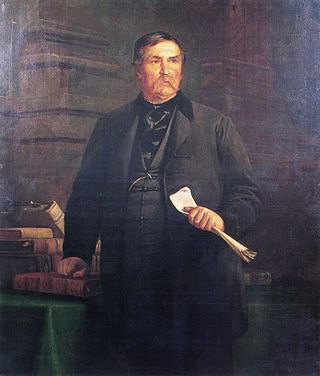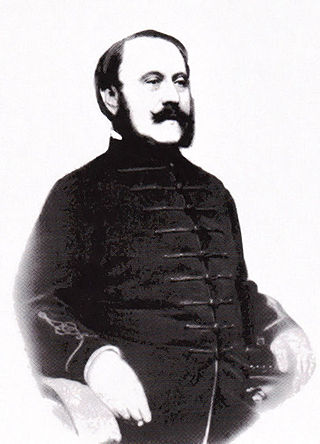
Lajos Kossuth de Udvard et Kossuthfalva was a Hungarian nobleman, lawyer, journalist, politician, statesman and governor-president of the Kingdom of Hungary during the revolution of 1848–1849.

The Austro-Hungarian Compromise of 1867 established the dual monarchy of Austria-Hungary, which was a military and diplomatic alliance of two sovereign states. The Compromise only partially re-established the former pre-1848 sovereignty and status of the Kingdom of Hungary, being separate from, and no longer subject to, the Austrian Empire. The compromise put an end to the 18-year-long military dictatorship and absolutist rule over Hungary which Emperor Franz Joseph had instituted after the Hungarian Revolution of 1848. The territorial integrity of the Kingdom of Hungary was restored. The agreement also restored the old historic constitution of the Kingdom of Hungary.

Ferenc Deák de Kehida was a Hungarian statesman and Minister of Justice. He was known as "The Wise Man of the Nation" and one of the greatest figures of Hungary's liberal movement.

Count Lajos Batthyány de Németújvár was the first Prime Minister of Hungary. He was born in Pozsony on 10 February 1807, and was executed by firing squad in Pest on 6 October 1849, the same day as the 13 Martyrs of Arad.

Baron Zsigmond Kemény was a Hungarian author.

Count István Imre Lajos Pál Tisza de Borosjenő et Szeged ; was a politician who served as prime minister of Hungary from 1903 to 1905 and from 1913 until 1917. He was also a political scientist, international lawyer, macroeconomist, member of the Hungarian Academy of Sciences and champion duelist. The outbreak of World War One defined his second term as prime minister. He was killed by leftist revolutionaries on 31 October 1918 during the Aster Revolution, the day Hungary declared its independence, dissolving the Dual Monarchy or Austro-Hungarian Empire. Tisza was the most zealous adherent of the Dual Monarchy among the Hungarian political leaders and pleaded for consensus between liberals and conservatives. As a Member of the Imperial Council since 1887, he came to fear a political impasse in the conflict between the unyielding temper of the Emperor and the revolutionary spirit of the extremists. Tisza was bitterly unpopular among ethnic Hungarian voters and therefore - similarly to his father Kálmán Tisza - he drew most of his votes from ethnic minorities during the parliamentary elections.
This article gives an overview of liberalism and radicalism in Hungary. It is limited to liberal and radical parties with substantial support, mainly proved by having had a representation in parliament. The sign ⇒ denotes another party in that scheme. For inclusion in this scheme it is not necessary that parties labeled themselves as a liberal party.

The Kingdom of Hungary between 1526 and 1867 existed as a state outside the Holy Roman Empire, but part of the lands of the Habsburg monarchy that became the Austrian Empire in 1804. After the Battle of Mohács in 1526, the country was ruled by two crowned kings. Initially, the exact territory under Habsburg rule was disputed because both rulers claimed the whole kingdom. This unsettled period lasted until 1570 when John Sigismund Zápolya abdicated as King of Hungary in Emperor Maximilian II's favor.

Kálmán Széll de Duka et Szentgyörgyvölgy was a Hungarian politician who served as Prime Minister of Hungary from 1899 to 1903.

The Young Czech Party was formed in the Bohemian crown land of Austria-Hungary in 1874. It initiated the democratization of Czech political parties and led to the establishment of the political base of Czechoslovakia.

The Hungarian Revolution of 1848, also known in Hungary as Hungarian Revolution and War of Independence of 1848–1849 was one of many European Revolutions of 1848 and was closely linked to other revolutions of 1848 in the Habsburg areas. Although the revolution failed, it is one of the most significant events in Hungary's modern history, forming the cornerstone of modern Hungarian national identity—the anniversary of the Revolution's outbreak, 15 March, is one of Hungary's three national holidays.

The revolutions of 1848, known in some countries as the Springtime of the Peoples or the Springtime of Nations, were a series of revolutions throughout Europe over the course of more than one year, from 1848 to 1849. It remains the most widespread revolutionary wave in European history to date.

The minister of foreign affairs of Hungary is a member of the Hungarian cabinet and the head of the Ministry of Foreign Affairs. The current foreign minister is Péter Szijjártó.
The Party of Independence and '48, also known mostly by its shortened form Independence Party, was one of the two major political parties in the Kingdom of Hungary within Austria-Hungary, along with the Liberal Party then National Party of Work. During its existence, the F48P strongly opposed the Austro-Hungarian Compromise of 1867. The party was revived after the fall of the Hungarian Soviet Republic and restoration of the monarchy.
The National Constitution Party, or simply Constitution Party, was a political party in Hungary from 1905 to 1910 and from 1913 to 1918.

The Hungarian State was a short-lived unrecognised state that existed for 4 months in the last phase of the Hungarian Revolution of 1848–49.
The Opposition Party was a political party that came to prominence during the 1848–49 revolution in Hungary. By contemporary political standards, they represented the far-left in the Hungarian parliament. It's leading political figure was Lajos Kossuth.

Ferenc Farkas de Boldogfa was a Hungarian nobleman, Zala county auditor, monetary comptroller of the county, administrative committee member of Zala county, economist, landowner.













